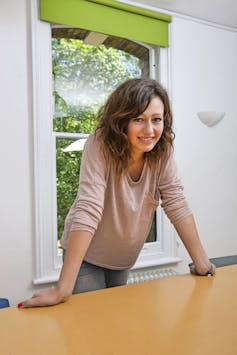Chemist John Dalton proposed the theory that all matter and objects are made up of particles called atoms, and this is still accepted by the scientific community, almost two centuries later. Each of these atoms is each made up of an incredibly small nucleus and even smaller electrons, which move around at quite a distance from the centre.
If you imagine a table that is a billion times larger, its atoms would be the size of melons. But even so, the nucleus at the centre would still be far too small to see and so would the electrons as they dance around it. So why don’t our fingers just pass through atoms, and why doesn’t light get through the gaps?
To explain why we must look at the electrons. Unfortunately, much of what we are taught at school is simplified – electrons do not orbit the centre of an atom like planets around the sun, like you may have been taught. Instead, think of electrons like a swarm of bees or birds, where the individual motions are too fast to track, but you still see the shape of the overall swarm.
Electrons ‘dance’
In fact, electrons dance – there is no better word for it. But it’s not random dancing – it’s more like ballroom dancing, where they move in set patterns, following steps laid down by a mathematical equation named after Erwin Schrödinger.

These patterns can vary – some are slow and gentle, like a waltz whereas some are fast and energetic, like a Charleston. Each electron keeps to the same pattern, but once in a while it may change to another, as long as no other electron is doing that pattern already. No two electrons in an atom can do the same step: this rule is called the Exclusion Principle.
Although electrons never tire, moving up to a faster step does take energy. And when an electron moves down to a slower pattern it loses energy which it gives out. So when energy in the form of light falls on an electron, it can absorb some energy and move up to a higher, faster “dance” pattern. A light beam won’t get far through our table, since the electrons in all the atoms are eager to grab some energy from the light.
After a very short while they lose this gained energy, perhaps as light again. Changes in the patterns of absorbed and reflected light give reflections and colours - so we see the table as solid.
Resistance when touched
So why does a table also feel solid? Many websites will tell you that this is due to the repulsion – that two negatively charged things must repel each other. But this is wrong, and shows you should never trust some things on the internet. It feels solid because of the dancing electrons.

If you touch the table, then the electrons from atoms in your fingers become close to the electrons in the table’s atoms. As the electrons in one atom get close enough to the nucleus of the other, the patterns of their dances change. This is because, an electron in a low energy level around one nucleus can’t do the same around the other – that slot’s already taken by one of its own electrons. The newcomer must step into an unoccupied, more energetic role. That energy has to be supplied, not by light this time but by the force from your probing finger.
So pushing just two atoms close to each other takes energy, as all their electrons need to go into unoccupied high-energy states. Trying to push all the table-atoms and finger-atoms together demands an awful lot of energy – more than your muscles can supply. You feel that, as resistance to your finger, which is why and how the table feels solid to your touch.

